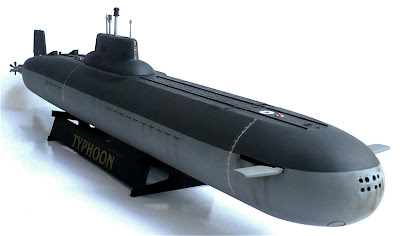Here are some more images of Dragon models 1/350 scale Acula class Typhoon Submarine.
From Wikipedia"
The Project 941 or Akula, Russian "Акула" ("Shark") class submarine (NATO reporting name: Typhoon) is a type of nuclear-powered ballistic missile submarine deployed by the Soviet Navy in the 1980s. With a submerged displacement of 48,000 tons, the Typhoons are the largest class of submarine ever built, large enough to accommodate decent living facilities for the crew when submerged for months on end. The source of the NATO reporting name remains unclear, although it is often claimed to be related to the use of the word "typhoon" ("тайфун") by Leonid Brezhnev
in a 1974 speech while describing a new type of nuclear ballistic
missile submarine. Soviet doctrine for these vessels was to patrol under
the Arctic ice cap and surface to launch SLBMs, avoiding the need to transit the GIUK gap and remaining safe from the enemy attack submarines and anti-submarine forces. Technically, Typhoons were also able to deploy their long-range nuclear missiles while moored at their docks.
The Russian Navy canceled its Typhoon modernization program in March
2012, stating that modernizing one Typhoon would be as expensive as
building two new Borei-class submarines. With the announcement that Russia has eliminated the last SS-N-20 Sturgeon SLBMs in September 2012, the remaining Typhoons have reached the end of service.
Typhoon submarines are among the quietest Russian sea vessels in
operation, being quieter and yet more maneuverable than their
predecessors. Besides their missile armament, the Typhoon class features six torpedo tubes; all of which are designed to handle RPK-2 (SS-N-15) missiles or Type 53 torpedoes. A Typhoon-class submarine can stay submerged for periods up to 120 days in normal conditions, and potentially more if deemed necessary (e.g., in the case of a nuclear war). Their primary weapons system is composed of 20 R-39 (NATO: SS-N-20) ballistic missiles (SLBM) with a maximum of 10 MIRV nuclear warheads each.
Typhoon-class submarines feature multiple pressure hulls that simplify internal design while making the vessel much wider than a normal submarine. In the main body of the sub, two Delta class
pressure hulls lie parallel with a third, smaller pressure hull above
them (which protrudes just below the sail), and two other pressure hulls
for torpedoes and steering gear. This also greatly increases their
survivability - even if one pressure hull is breached, the crew members
in the other are safe and there is less potential for flooding.
The Typhoon class was developed under Project 941 as the Russian ''Akula'' class (Акула), meaning shark. It is sometimes confused with other submarines, as Akula is the name NATO uses to designate the Russian Project 971 Shchuka-B (Щука-Б) class attack submarines. The project was developed with the objective to match the SLBM armament of Ohio-class submarines,
capable of carrying 192 nuclear warheads, 100 kt each. However, at the
time, state-of-the-art Soviet SLBMs were substantially larger and
heavier than their American counterparts (the R-39 is more than two
times heavier than the Trident I; it remains the heaviest SLBM in
service worldwide). The submarine had to be scaled accordingly.
Six Typhoon-class submarines were built. Originally, the submarines
were designated by hull numbers only. Names were later assigned to the
four vessels retained by the Russian Navy,
which were sponsored by either a city or company. The construction
order for an additional vessel (hull number TK-210) was canceled and
never completed. Only the first of these submarines to be constructed,
the Dmitriy Donskoy, is still in active service with the Russian Navy, serving as a test platform for the Bulava (SS-NX-32) missile which is currently under development. The Arkhangelsk (TK-17) and Severstal
(TK-20) remain commissioned, though not currently active with the
Russian fleet. All the R-39 missiles have been retired. The Typhoons are
slated to be replaced by the Borei class starting in 2010-11.
In late December 2008, a senior Navy official announced that the two Typhoon-class submarines, the TK-17 and TK-20, that are in reserve would not be rearmed with the new Bulava SLBM missile system. They could however be modified to carry cruise missiles or to lay mines, or could be used in special operations. In late June 2009, the Navy Commander-in-Chief, Admiral Vladimir Vysotsky told reporters that the two submarines would be reserved for possible future repairs and modernization.
In May 2010, the Navy Commander-in-Chief reported that Russia's
Typhoon-class submarines would remain in service with the Navy until
2019.
In September 2011, the Russian defense ministry decided to write off
all Project 941 Akula nuclear-powered ballistic missile submarines until
2014. The reason for decommission of the world's largest submarines are
restrictions imposed on Russia by the Strategic Arms Reduction Treaty
and successful trials of new Borei-class submarine.
However, according to other sources at the Russian defence ministry, no
such decision has been made; in that case, the submarines would remain
with the Russian Navy.,
Submarines TK-17 Arhangelsk and TK-20 Severstal will not be modernized
as platforms for cruise missiles, but they will be kept in service with
their previous armament, R-39 missiles.
In 2013, the State-Run RIA Novosti news has announced that the Navy
will scrap two Typhoons beginning 2018. They will be the TK-17 and
TK-20.







2 comments:
I assembled this kit, very nice and very impressive when compared to other submarines at same scale. Dragon, unfortunately, did not provide the fairing around propellers....
As so I found out later on. Oh well.
Post a Comment